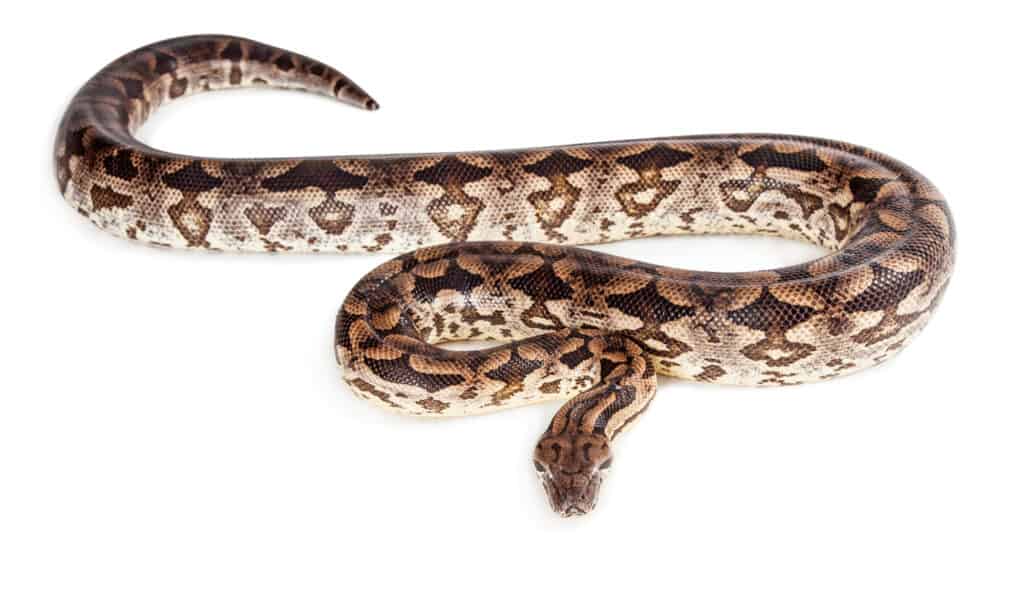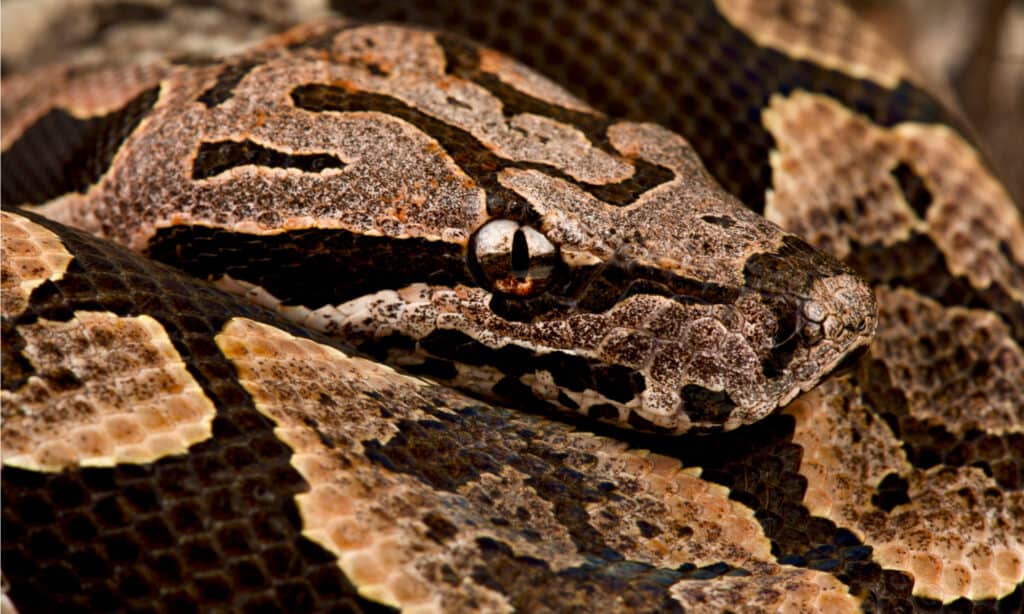Dumeril’s Boa
Acrantophis dumerili
Some tribes believe that the snake's skin holds the souls of their ancestors.
Advertisement
Dumeril’s Boa Scientific Classification
- Kingdom
- Animalia
- Phylum
- Chordata
- Class
- Reptilia
- Order
- Squamata
- Family
- Boidae
- Genus
- Acrantophis
- Scientific Name
- Acrantophis dumerili
Read our Complete Guide to Classification of Animals.
Dumeril’s Boa Conservation Status
Dumeril’s Boa Facts
- Prey
- small mammals, birds, eggs, lizards
- Main Prey
- rats and juvenile lemurs
- Name Of Young
- neonates
- Group Behavior
- Solitary except during mating season
- Fun Fact
- Some tribes believe that the snake's skin holds the souls of their ancestors.
- Biggest Threat
- People who kill them out of fear.
- Other Name(s)
- do, Dumeril's ground boa,
- Litter Size
- 5-15
- Lifestyle
- Nocturnal
- Favorite Food
- juvenile lemurs
- Location
- Madagascar
Dumeril’s Boa Physical Characteristics
- Color
- Brown
- Grey
- Fawn
- Dark Brown
- Chocolate
- Black-Brown
- Skin Type
- Scales
- Lifespan
- 15-20years
- Weight
- up to 20 pounds
- Length
- 4-7 feet
- Age of Sexual Maturity
- 3-5
- Venomous
- No
- Aggression
- Low
View all of the Dumeril’s Boa images!
Dumeril’s boa is a medium-sized boa that, while popular as a pet, is native to Madagascar.
It eats various small animals, but juvenile lemurs are its favorite prey item. This snake was heavily exported for the pet trade. To protect it in the wild, Madagascar added local protections, and CITES added it to Appendix I.
3 Amazing Facts About Dumeril’s Boa
- The Malagash word for this boa is “do,” which is pronounced like “dough.” Malagash is the native language on the island.
- Some people keep them to help with rodent control but are feared by others who kill them on sight.
- This species is pretty mild-mannered but bites if it’s startled.
Where to Find Dumeril’s Boa
Dumeril’s boa is endemic to Madagascar in the south and southwest parts of the island. It’s a terrestrial species that doesn’t climb trees often, although juveniles sometimes use them as hiding places. This boa is most active at night, although if the weather is cooler, it can also be active during the early morning and evening hours.
The snake is often found in dry forest areas, along the western coast and southwestern regions of Madagascar. It hides in leaf litter, at the edges of the forest, around buildings, and wherever there might be small animals including birds, lizards, juvenile lemurs, and rodents to eat. Sometimes it’s killed because it also hunts domestic poultry.
A juvenile Dumeril’s boa has to contend with many threats to its safety – anything from hawks to fossas and other predators are likely to hunt it. As it grows larger, the threats to its safety become fewer, but some animals still prey on it. People are often its most significant threat because they sometimes kill it out of fear.
Dumeril’s Boa Scientific Name
This species’ scientific name, Acrantophis dumerili, means”Dumeril’s lazy snake.” Here’s how that works: Acrantophis comes from two Greek words – “akrantos” for lazy or useless, and “ophis” which means snake. Scientists named Dumeril’s boa in honor of the French herpetologist, André Marie Constant Duméril, hence the specific epithet, dumerili.
There are two species in the Acrantophis genus, A. dumerili, and A. madagascariensis. They are both endemic to Madagascar and the Mascarene islands off the coast of Madagascar, and both are terrestrial species.
Population and Conservation Status of Dumeril’s Boa
In 1991, the IUCN determined that this species was vulnerable to extinction, primarily due to over-collecting for the pet trade. However, after this assessment, this and the other boas on the islands were protected from export when CITES added them to Appendix I. As of 2011, they were reclassified as Least Concern by the IUCN.
Since that time, Dumeril’s boa population has recovered and it has adapted really well to the changes that people bring when they build homes and communities. It is a highly adaptable species, well-suited to living near human settlements. Some people even keep it to help with rodent control.
Identifying Dumeril’s Boa: Appearance and Description
Dumeril’s boa typically has a tan to a grayish-tan base color, overlayed with dark-chocolate-colored markings. Its markings sometimes look oddly human-face-shaped, and the snake often looks like an earth-toned version of a kaleidoscope. Because it’s a ground-dwelling boa, it often hides in leaf litter. The snake’s kaleidoscope-like markings help it blend in so well that you might not even spot one until you’re right on top of it.
Its head is rather aggressively-shaped; it comes to a point at the nose and widens considerably towards the jaw. Its head is often slightly darker than the rest of the body and it has elliptical pupils, as do most boas.
This snake ranges from three to six feet long as an adult, although some individuals can reach seven feet. Being a constrictor, this is a thick-bodied and muscular snake. A few may sometimes reach nine feet, but those are rare. This species is sexually dimorphic, and the female is generally longer and chunkier than the male, while the male has spurs used for courtship.
The mating season in the wild for Dumeril’s boa is from March through May. Females generally mate every other year and give live birth to litters of 6-28 approximately 6-8 months after mating. The babies, called neonates, are 12-18 inches long when they’re born and are immediately ready to fend for themselves. Most snakes reach maturity between three and five years of age.

Dumeril’s boa is native to Madagascar.
©Matt_Gibson/Shutterstock.com
Pictures and Videos of Dumeril’s Boa

These snakes sometimes reaches 7 feet long.
©GoodFocused/Shutterstock.com

These boas have elliptical, cat-eye pupils.
©reptiles4all/Shutterstock.com
How Dangerous are Dumeril’s Boa
Like any wild animal, it will bite when it feels threatened. However, its bite will leave little more than a scar because Dumeril’s boa is nonvenomous. Snakes are nature’s best rodent control. Even though they frighten some people, these creatures want to be left alone to do what they do best.
Dumeril’s Boa Behavior and Humans
Unfortunately, this snake sometimes becomes the target of humans who are afraid of it. In some areas, people kill it on sight. The patterns on the side of its body sometimes look like faces. In some folk legends, the souls of tribal ancestors are in the snake skins, making Dumeril’s boa sacred to those tribes.
This snake is generally mild-mannered, which makes them great pets. Some individuals can be bitier than others, so it’s important to be patient with it. It is easy to obtain from breeders in the U.S. and other countries. Keepers say that its most significant challenge is that the boa becomes stressed more quickly than other species.
View all 110 animals that start with DDumeril’s Boa FAQs (Frequently Asked Questions)
Are Dumeril's boas aggressive?
No, however, they can be startled more easily than other boas, and bite because of that.
What do they eat?
Dumeril’s boas eat a variety of rodents, juvenile lemurs, birds, and lizards.
How do they hunt?
Like other boas, Dumeril’s boa is an ambush predator and prefers to sit and wait while its food comes to it.
Where do Dumeril's boas live?
Only on Madagascar, but there may also be some in the Mascarene islands east of Madagascar.
Thank you for reading! Have some feedback for us? Contact the AZ Animals editorial team.
Sources
- Vences, Miguel, et al. “Phylogeny of South American and Malagasy Boine Snakes: Molecular Evidence for the Validity of Sanzinia and Acrantophis and Biogeographic Implications.” Copeia, vol. 2001, no. 4, 2001, pp. 1151–54, http://www.jstor.org/stable/1448408. Accessed 11 May 2022. / Published December 20, 2001 / Accessed May 11, 2022
- IUCN Redlist / Published January 24, 2011 / Accessed May 11, 2022
- Reptile Database / Accessed May 11, 2022
- CITES Appendices / Accessed May 12, 2022


















